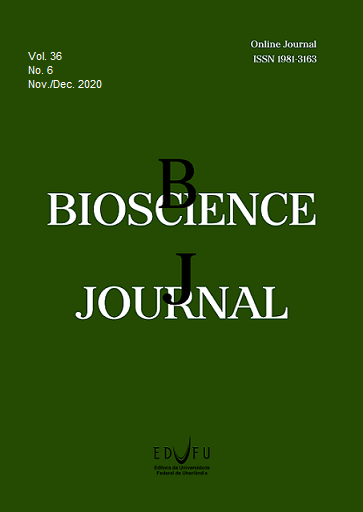Comparison among chemical thinners applied to ‘Maciel’ and ‘Sensação’ peach trees
DOI:
https://doi.org/10.14393/BJ-v36n6a2020-48010Keywords:
Abscission., Prunus persica., Benzyladenine., Metamitron., Ethephon., Production.Abstract
Peach tree thinning, which aims at reducing plant load so as to ensure productivity and fruit quality, has been manually carried out within a short period of time in the stage of fruit development. Due to the need and shortage of qualified man power, chemical thinning is one of the alternatives that can solve these difficulties found in manual thinning. This study aimed at evaluating the effect of different products which have been applied – either alone or in combination – to fruit thinning of peach tree cultivars ‘Sensação’ and ‘Maciel’ in Pelotas, Rio Grande do Sul (RS) state, Brazil. The experiment was conducted in the 2015/2016 crop in a commercial peach orchard located in Morro Redondo, RS, Brazil. The following seven treatments were carried out 40 days after full bloom (DAFB): plants with no thinning, manual thinning, metamitron, benzyladenine, benzyladenine + metamitron, ethephon, ethephon + metamitron. Fruit abscission, effective fructification, number of fruits and production per plant, mean mass and fruit classification into caliber classes, epidermis color, pulp firmness and soluble solids were evaluated. Production and number of fruits per plant decreased excessively, whereas fruits placed in categories of higher caliber increased when ethephon was either used alone or in combination with metamitron. When both metamitron and benzyladenine were applied, either alone or in combination, they led to fruit abscission and resulted in mean fruit size and weight, at harvest time, similar to those found in manual thinning. Application of chemical products – either alone or in combination – may be an alternative of peach tree thinning in orchard management.
Downloads
Published
Issue
Section
License
Copyright (c) 2020 Roseli de Mello Farias, Caroline Farias Barreto, Renan Ricardo Zandoná, Carlos Roberto Martins, Paulo Celso de Mello Farias, Marcelo Barbosa Malgarim

This work is licensed under a Creative Commons Attribution 4.0 International License.





